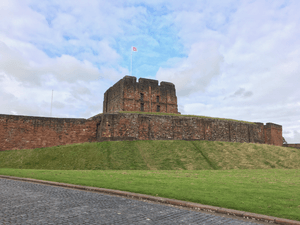Siege of Carlisle (1644) facts for kids
Quick facts for kids Siege of Carlisle |
|||||||
|---|---|---|---|---|---|---|---|
| Part of the First English Civil War | |||||||
 Carlisle Castle |
|||||||
|
|||||||
| Belligerents | |||||||
| Commanders and leaders | |||||||
| Earl of Leven | Sir Thomas Glennam Sir Henry Shadling |
||||||
| Strength | |||||||
| 4,000 | 700 | ||||||
| Casualties and losses | |||||||
| Low | Low | ||||||
The siege of Carlisle was an important event during the First English Civil War. It happened when Scottish and English armies, called the Covenanters and Parliamentarians, surrounded Carlisle Castle. The castle was defended by the Royalists, who were loyal to King Charles I. This siege took place in Carlisle, Cumbria, from October 1644 to June 25, 1645.
Contents
Why Carlisle Was Important
For 500 years, Carlisle Castle was a key fortress. It guarded England's northwestern border with Scotland. When the First English Civil War began in 1642, Royalist forces controlled the castle. Because it was so far north, the Royalists kept control for the first two years of the war.
Royalist Defeat at Marston Moor
On July 2, 1644, the Covenanters and Parliamentarians won a huge victory. They defeated the Royalists at the Battle of Marston Moor near York. The Royalists lost 5,500 soldiers. They also lost all their cannons, gunpowder, and supplies. Two weeks later, the city of York surrendered.
The Royalist commander, the Marquis of Newcastle, and other leaders left the country. This meant the Royalists no longer had a strong army in the north.
Covenanters Move North
After the Parliamentarian victory, Alexander Leslie led the Covenanters. He started a campaign to capture Royalist strongholds and cities in the north. By August 15, Leslie's army reached the important port city of Newcastle. They began a new siege there, as an earlier one had failed.
The Siege Begins
After Newcastle surrendered on October 27, 1644, Leslie moved his army. He took 4,000 Covenanter soldiers, both foot soldiers and cavalry, to Carlisle. There, they began to surround the walled city and its fortress.
Leslie set up his forces in villages around Carlisle. He also built siege works on the four main roads leading into the city. One siege work, blocking the northern road, was in the churchyard at Stanwix. It had three small cannons. The other siege works were forts for 60 to 100 cavalry riders. These four forts blocked all access to the city and castle.
A Long Wait
At first, the Royalists in Carlisle still had plenty of land for their animals outside the city walls. Leslie did not seem to be in a hurry. For about six months, he waited. The Covenanters did not attack the city. During this time, the main fighting was small skirmishes. Royalist soldiers would leave the city to find cattle and supplies.
Tightening the Circle
In the spring, Parliamentarian forces joined the Covenanters. Around late April, Leslie started moving his siege works closer to the city. He also built more forts. This made it harder for the Royalists to get food. Their supplies began to run out.
Starvation became a serious problem for the soldiers inside the castle. They had to eat whatever they could find, including horses, dogs, and even rats.
The End of the Siege
In the summer of 1645, King Charles and his Royalist army lost another major battle. This was the Battle of Naseby. With no food left and little hope of help, the Royalist soldiers at Carlisle Castle surrendered. This happened on June 25, 1645.
What Happened Next
The agreement for Carlisle Castle's surrender was called the "Articles of Agreement for the Surrender of Carlisle Castle." It included these important points:
- The castle, city, and Citadel of Carlisle, along with all forts, towers, cannons, ammunition, and furniture, would be given to Lieutenant General Leslie.
- Sir Thomas Glennam, Sir Henry Stradling, and their soldiers could march out of Carlisle as free men. They could carry their flags and play their drums. They could leave with their firearms, bags, and twelve charges of gunpowder each. They were allowed to march to join their King without being attacked.
- The people of Carlisle would not be harmed. Their homes would not be looted or destroyed.

